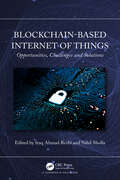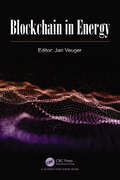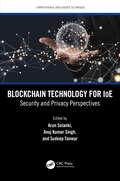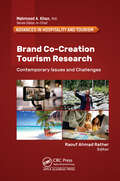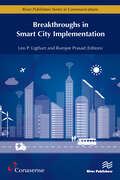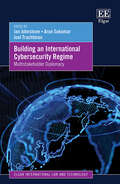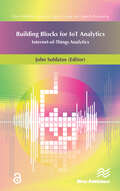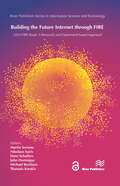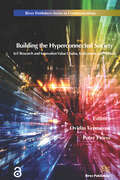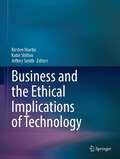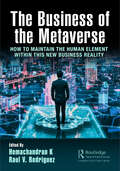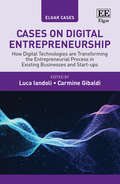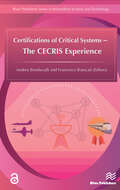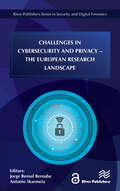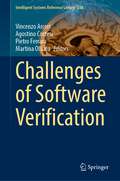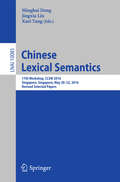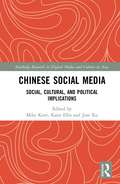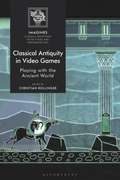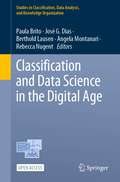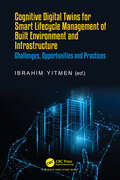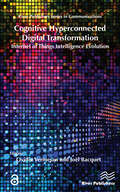- Table View
- List View
Blockchain-based Internet of Things: Opportunities, Challenges and Solutions
This book presents an overview of the blockchain-based Internet of Things systems, along with the opportunities, challenges, and solutions in diverse fields such as business, education, agriculture, and healthcare. It discusses scalability, security, layers, threats, and countermeasures in blockchain-based Internet of Things network.· Elaborates on the opportunities presented by combining blockchain with artificial intelligence on the Internet of Things systems in the management of food systems, and drug supply chains.· Explains the management of computationally intensive tasks in blockchain-based Internet of Things through the development of lightweight protocols.· Presents various applications in fields including logistics and the supply chain, automobile industry, smart housing, shared economy, and agriculture.· Provides insights into blockchain-based Internet of Things systems, along with their features, vulnerabilities, and architectural flaws.· The text is primarily written for graduate students, and academic researchers working in the fields of computer science and engineering, electrical engineering, and information technology.
Blockchain in Energy
The global energy crisis is accelerating, and within Europe, the European Union (EU) is actively working to address this challenge through policy frameworks and political management. However, the energy market remains fiercely competitive, prompting us to explore alternative energy sources and rethink how we generate, distribute, and utilize power. This, in turn, raises questions about the allocation of power, energy availability, and usage in various contexts.Furthermore, the digital realm is undergoing rapid transformation across multiple sectors. Drawing on my expertise in blockchain technology, I recognize numerous opportunities to enhance the transparency and reliability of data related to energy issues. By leveraging blockchain, we can ensure that the information available is trustworthy and insightful for every user.The aim of this book is to share my knowledge in the realm of energy and blockchain. It addresses the urgency of addressing global energy challenges and acknowledges the pivotal role of the EU in this endeavor. It also highlights the intensity of competition in the energy market and the need for innovative approaches. The book also demonstrates how blockchain can contribute to solving these issues, empowering individuals and organizations with reliable information and insights in the field of energy and blockchain technology.
Blockchain Technology for IoE: Security and Privacy Perspectives (Computational Intelligence Techniques)
This book explores opportunities and challenges in the field of Internet of Everything (IoE) security and privacy under the umbrella of distributed ledger technologies and blockchain technology including distributed consensus mechanisms, crypto-sensors, encryption algorithms, and fault tolerance mechanisms for devices and systems. It focusses on the applicability of blockchain technology, including architectures and platforms for blockchain and IoE, authentication and encryption algorithms for IoE, malicious transactions detection, blockchain for forensics, and so forth. Outlines the major benefits as well as challenges associated with integration of blockchain with IoE; Describes detailed framework to provide security in IoE using blockchain technology; Reviews various issues while using distributed ledger technologies for IoE; Provides comprehensive coverage of blockchain for IoE in securing information including encryption schemes, authentication, security issues, and challenges; Includes case studies in realistic situations like healthcare informatics, smart industry, and smart transportation. This book is aimed at researchers and graduate students in computing, cryptography, IoT, computer engineering, and networks.
Brand Co-Creation Tourism Research: Contemporary Issues and Challenges (Advances in Hospitality and Tourism)
Responding to the rapidly changing business landscape (including advances in social media and information technology) and the COVID-19 pandemic where customers, visitors, or tourists have become more connected, accessible, and informed than ever before, many brands and firms are investing in brand management and brand co-creation. This new volume provides an enlightening perspective on brand co-creation, brand management, and branding through contemporary conceptual discussions and empirical research studies from thought leaders. Providing a step-by-step guide to the brand co-creation and branding process in the hospitality and tourism industry, the volume identifies cutting-edge measurements, strategies, and metrics for capturing and measuring brand co-creation and highlights best practices in implementing brand management marketing strategies. Starting with a basic understanding of brand (value) co-creation, the volume then explores deeper by defining the concept, describing the ways to measure it, and providing several strategies to capitalize on it. The authors emphasize the interrelationship of these concepts and how they manage brand co-creation. The book illustrates the concepts with examples from around the globe. Topics cover the impact of social media on brand co-creation during the COVID-19 outbreak in the tourism industry, co-branding emerging tourist destinations, analysis of the content of hotel websites, creating better customer value, brand co-creation in e-sports gaming events, post-COVID-19 educational tourism, and more. The volume also presents a chapter on the state-ofthe-art role of augmented reality and virtual reality in improving the customer experience. A synthesis of a decade-long effort in brand co-creation, the book will be valuable to academics, practitioners, consultants, destination management organizations (DMOs), and managers looking to improve brand co-creation pre-, during-, and post-pandemics.
Breakthroughs in Smart City Implementation
Breakthroughs in Smart City Implementation should give answers on a wide variety of present social, political and technological problems. Green and long-lasting solutions are needed in coming 10 years and beyond on areas as green and long lasting solutions for improving air quality, quality of life of residents in cities, traffic congestions and many more.Two Conasense branches, established in China and in India, report in six book chapters on initiatives needed to overcome the obvious shortcomings at present. Three more chapters complete this fifth Conasense book: an introductory chapter concerning Smart City from Conasense perspective, a chapter showing that not technology but the people in the cities are most important and a chapter on recent results and prospects of “Human in the Loop” in smart vehicular systems.
Building an International Cybersecurity Regime: Multistakeholder Diplomacy (Elgar International Law and Technology series)
Providing a much-needed study on cybersecurity regime building, this comprehensive book is a detailed analysis of cybersecurity norm-making processes and country positions, through the lens of multi-stakeholder diplomacy. Multidisciplinary and multinational scholars and practitioners use insights drawn from high-level discussion groups to provide a rigorous analysis of how major cyber powers view multi-stakeholder diplomacy.Looking at how past cybersecurity initiatives and multi-stakeholder negotiations in other fields illuminate its dynamics, this book will help put states' approaches towards multi-stakeholder cyber diplomacy into perspective, and frame the role of private actors in cybersecurity regime building. Evaluating the most promising institutional arrangements and mechanisms for implementing cybersecurity, this book combines top-down analyses relevant to the design of international cybersecurity regimes with bottom-up case studies, tracing the approaches of important states towards multi-stakeholder participation in cyber diplomacy.With a wealth of policy-relevant findings, this book will be welcomed by practitioners and scholars of international law, international organization and international cybersecurity as well as multi-stakeholder governance and multilateral regimes. Policymakers and diplomats involved in international cybersecurity processes will also benefit from its cutting-edge comparative analysis of the approaches of key cyber powers.
Building Blocks for IoT Analytics Internet-of-Things Analytics
Internet-of-Things (IoT) Analytics are an integral element of most IoT applications, as it provides the means to extract knowledge, drive actuation services and optimize decision making. IoT analytics will be a major contributor to IoT business value in the coming years, as it will enable organizations to process and fully leverage large amounts of IoT data, which are nowadays largely underutilized. The Building Blocks of IoT Analytics is devoted to the presentation the main technology building blocks that comprise advanced IoT analytics systems. It introduces IoT analytics as a special case of BigData analytics and accordingly presents leading edge technologies that can be deployed in order to successfully confront the main challenges of IoT analytics applications. Special emphasis is paid in the presentation of technologies for IoT streaming and semantic interoperability across diverse IoT streams. Furthermore, the role of cloud computing and BigData technologies in IoT analytics are presented, along with practical tools for implementing, deploying and operating non-trivial IoT applications. Along with the main building blocks of IoT analytics systems and applications, the book presents a series of practical applications, which illustrate the use of these technologies in the scope of pragmatic applications. Technical topics discussed in the book include: Cloud Computing and BigData for IoT analyticsSearching the Internet of ThingsDevelopment Tools for IoT Analytics ApplicationsIoT Analytics-as-a-ServiceSemantic Modelling and Reasoning for IoT AnalyticsIoT analytics for Smart BuildingsIoT analytics for Smart CitiesOperationalization of IoT analyticsEthical aspects of IoT analyticsThis book contains both research oriented and applied articles on IoT analytics, including several articles reflecting work undertaken in the scope of recent European Commission funded projects in the scope of the FP7 and H2020 programmes. These articles present results of these projects on IoT analytics platforms and applications. Even though several articles have been contributed by different authors, they are structured in a well thought order that facilitates the reader either to follow the evolution of the book or to focus on specific topics depending on his/her background and interest in IoT and IoT analytics technologies. The compilation of these articles in this edited volume has been largely motivated by the close collaboration of the co-authors in the scope of working groups and IoT events organized by the Internet-of-Things Research Cluster (IERC), which is currently a part of EU's Alliance for Internet of Things Innovation (AIOTI).
Building the Future Internet through FIRE: a Research and Experimentation based Approach
The Internet as we know it today is the result of a continuous activity for improving network communications, end user services, computational processes and also information technology infrastructures. The Internet has become a critical infrastructure for the human-being by offering complex networking services and end-user applications that all together have transformed all aspects, mainly economical, of our lives. Recently, with the advent of new paradigms and the progress in wireless technology, sensor networks and information systems and also the inexorable shift towards everything connected paradigm, first as known as the Internet of Things and lately envisioning into the Internet of Everything, a data-driven society has been created. In a data-driven society, productivity, knowledge, and experience are dependent on increasingly open, dynamic, interdependent and complex Internet services. The challenge for the Internet of the Future design is to build robust enabling technologies, implement and deploy adaptive systems, to create business opportunities considering increasing uncertainties and emergent systemic behaviors where humans and machines seamlessly cooperate.
Building the Hyperconnected Society- Internet of Things Research and Innovation Value Chains, Ecosystems and Markets
This book aims to provide a broad overview of various topics of Internet of Things (IoT), ranging from research, innovation and development priorities to enabling technologies, nanoelectronics, cyber-physical systems, architecture, interoperability and industrial applications. All this is happening in a global context, building towards intelligent, interconnected decision making as an essential driver for new growth and co-competition across a wider set of markets. It is intended to be a standalone book in a series that covers the Internet of Things activities of the IERC – Internet of Things European Research Cluster from research to technological innovation, validation and deployment.The book builds on the ideas put forward by the European Research Cluster on the Internet of Things Strategic Research and Innovation Agenda, and presents global views and state of the art results on the challenges facing the research, innovation, development and deployment of IoT in future years. The concept of IoT could disrupt consumer and industrial product markets generating new revenues and serving as a growth driver for semiconductor, networking equipment, and service provider end-markets globally. This will create new application and product end-markets, change the value chain of companies that creates the IoT technology and deploy it in various end sectors, while impacting the business models of semiconductor, software, device, communication and service provider stakeholders. The proliferation of intelligent devices at the edge of the network with the introduction of embedded software and app-driven hardware into manufactured devices, and the ability, through embedded software/hardware developments, to monetize those device functions and features by offering novel solutions, could generate completely new types of revenue streams. Intelligent and IoT devices leverage software, software licensing, entitlement management, and Internet connectivity in ways that address many of the societal challenges that we will face in the next decade.
Business and the Ethical Implications of Technology
This book focuses on how firms should engage ethical choices in developing and deploying digital technologies. Digital technologies are devices that rely on rapidly accelerating digital sensing, storage, and transmission capabilities to intervene in human processes. While the ethics of technology is analyzed across disciplines from science and technology studies (STS), engineering, computer science, critical management studies, and law, less attention is paid to the role that firms and managers play in the design, development, and dissemination of technology across communities and within their firm. This book covers the topic from three angles. First, it illuminates diverse facets of the intersection of technology and business ethics. Second, it uses themes to explore what business ethics offers to the study of technology and, third, what technology studies offers to the field of business ethics. Each field brings expertise that, together, improves our understanding of the ethical implications of technology. Chapter “A Micro-ethnographic Study of Big Data-Based Innovation in the Financial Services Sector: Governance, Ethics and Organisational Practices", chapter ”The Challenges of Algorithm-Based HR Decision-Making for Personal Integrity" and chapter “Female CEOs and Core Earnings Quality: New Evidence on the Ethics Versus Risk-Aversion Puzzle" are available open access under a Creative Commons Attribution 4.0 International license via link.springer.com.
The Business of the Metaverse: How to Maintain the Human Element Within this New Business Reality
The metaverse is the future of business applications and models, and this ground-breaking book points and details a complete and clear picture of how the metaverse can impact the various business segments and how the human element will be maintained within the evolutionary change. This book serves as a guide for those planning to implement and expand the metaverse in their business as well as those already using it on limited levels. Simulated intelligence innovation can reveal intricate and significant examples in robust and information-rich situations that posture difficulties for human insight. In addition, similar to other burgeoning advancements, the experience and aptitudes accumulated by vendors and consumers, alongside the steady analysis of interactions and information, empower metaverse calculations to be refined and improved. This book illustrates the current advancements and results and expands the analysis of human-centric metaverse applications to business segments and their future effects on overall enterprise management. Essentially, this book elaborates on the impact of the metaverse across business sectors through the use of case studies.
Cases on Digital Entrepreneurship: How Digital Technologies are Transforming the Entrepreneurial Process in Existing Businesses and Start-ups (Elgar Cases in Entrepreneurship)
How are digital technologies changing the creation of new ventures? What are the critical skills for entrepreneurs in the digital age? How does digitalization change product design and communication with customers? How can small businesses in non-digital industries overcome the digital divide? This book helps answer these questions through real-world case studies and lessons learnt from the perspectives of real entrepreneurs in various industries, countries and types of business. Each case has abundant materials to support learning and reflection, including:discussion questions and assignments to stretch studentsdecision-making simulationsrich and detailed teaching notes to help enliven your teaching.Highlighting how entrepreneurship is changing in the digital age, this book will be an excellent resource for teachers and students of entrepreneurship, innovation management, new venture creation, marketing and strategy.
Certifications of Critical Systems – The CECRIS Experience
In recent years, a considerable amount of effort has been devoted, both in industry and academia, to the development, validation and verification of critical systems, i.e. those systems whose malfunctions or failures reach a critical level both in terms of risks to human life as well as having a large economic impact.Certifications of Critical Systems – The CECRIS Experience documents the main insights on Cost Effective Verification and Validation processes that were gained during work in the European Research Project CECRIS (acronym for Certification of Critical Systems). The objective of the research was to tackle the challenges of certification by focusing on those aspects that turn out to be more difficult/important for current and future critical systems industry: the effective use of methodologies, processes and tools.The CECRIS project took a step forward in the growing field of development, verification and validation and certification of critical systems. It focused on the more difficult/important aspects of critical system development, verification and validation and certification process. Starting from both the scientific and industrial state of the art methodologies for system development and the impact of their usage on the verification and validation and certification of critical systems, the project aimed at developing strategies and techniques supported by automatic or semi-automatic tools and methods for these activities, setting guidelines to support engineers during the planning of the verification and validation phases.
Challenges in Cybersecurity and Privacy - the European Research Landscape
Cybersecurity and Privacy issues are becoming an important barrier for a trusted and dependable global digital society development. Cyber-criminals are continuously shifting their cyber-attacks specially against cyber-physical systems and IoT, since they present additional vulnerabilities due to their constrained capabilities, their unattended nature and the usage of potential untrustworthiness components. Likewise, identity-theft, fraud, personal data leakages, and other related cyber-crimes are continuously evolving, causing important damages and privacy problems for European citizens in both virtual and physical scenarios.In this context, new holistic approaches, methodologies, techniques and tools are needed to cope with those issues, and mitigate cyberattacks, by employing novel cyber-situational awareness frameworks, risk analysis and modeling, threat intelligent systems, cyber-threat information sharing methods, advanced big-data analysis techniques as well as exploiting the benefits from latest technologies such as SDN/NFV and Cloud systems. In addition, novel privacy-preserving techniques, and crypto-privacy mechanisms, identity and eID management systems, trust services, and recommendations are needed to protect citizens’ privacy while keeping usability levels.The European Commission is addressing the challenge through different means, including the Horizon 2020 Research and Innovation program, thereby financing innovative projects that can cope with the increasing cyberthreat landscape. This book introduces several cybersecurity and privacy research challenges and how they are being addressed in the scope of 15 European research projects.Each chapter is dedicated to a different funded European Research project, which aims to cope with digital security and privacy aspects, risks, threats and cybersecurity issues from a different perspective. Each chapter includes the project’s overviews and objectives, the particular challenges they are covering, research achievements on security and privacy, as well as the techniques, outcomes, and evaluations accomplished in the scope of the EU project.The book is the result of a collaborative effort among relative ongoing European Research projects in the field of privacy and security as well as related cybersecurity fields, and it is intended to explain how these projects meet the main cybersecurity and privacy challenges faced in Europe. Namely, the EU projects analyzed in the book are: ANASTACIA, SAINT, YAKSHA, FORTIKA, CYBECO, SISSDEN, CIPSEC, CS-AWARE. RED-Alert, Truessec.eu. ARIES, LIGHTest, CREDENTIAL, FutureTrust, LEPS. Challenges in Cybersecurity and Privacy - the European Research Landscape is ideal for personnel in computer/communication industries as well as academic staff and master/research students in computer science and communications networks interested in learning about cyber-security and privacy aspects.
Challenges of Software Verification (Intelligent Systems Reference Library #238)
This book provides an overview about the open challenges in software verification. Software verification is a branch of software engineering aiming at guaranteeing that software applications satisfy some requirements of interest. Over the years, the software verification community has proposed and considered several techniques: abstract interpretation, data-flow analysis, type systems, model checking are just a few examples. The theoretical advances have been always motivated by practical challenges that have led to an equal evolution of both these sides of software verification. Indeed, several verification tools have been proposed by the research community and any software application, in order to guarantee that certain software requirements are met, needs to integrate a verification phase in its life cycle, independently of the context of application or software size. This book is aimed at collecting contributions discussing recent advances in facing open challenges in software verification, relying on a broad spectrum of verification techniques. This book collects contributions ranging from theoretical to practical arguments, and it is aimed at both researchers in software verification and their practitioners.
Chinese Lexical Semantics: 17th Workshop, CLSW 2016, Singapore, Singapore, May 20–22, 2016, Revised Selected Papers (Lecture Notes in Computer Science #10085)
This book constitutes the thoroughly refereed post-workshop proceedings of the 17th Chinese Lexical Semantics Workshop, CLSW 2016, held in Singapore, Singapore, in May 2016. The 70 regular papers included in this volume were carefully reviewed and selected from 182 submissions. They are organized in topical sections named: lexicon and morphology, the syntax-semantics interface, corpus and resource, natural language processing, case study of lexical semantics, extended study and application.
Chinese Social Media: Social, Cultural, and Political Implications (Routledge Research in Digital Media and Culture in Asia)
This book brings together scholars from a variety of disciplines to address critical perspectives on Chinese language social media, internationalizing the state of social media studies beyond the Anglophone paradigm. The collection focuses on the intersections between Chinese language social media and disability, celebrity, sexuality, interpersonal communication, charity, diaspora, public health, political activism and non-governmental organisations (NGOs). The book is not only rich in its theoretical perspectives but also in its methodologies. Contributors use both qualitative and quantitative methods to study Chinese social media and its social–cultural–political implications, such as case studies, in-depth interviews, participatory observations, discourse analysis, content analysis and data mining.
Choreomata: Performance and Performativity after AI
Is artificial intelligence (AI) becoming more and more expressive, or is human thought adopting more and more structures from computation? What does it mean to perform oneself through AI, or to construct one’s subjectivity through AI? How does AI continue to complicate what it means to have a body? Has the golden age of AI, especially with regards to creative applications, already ended? Choreomata: Performance and Performativity after AI is a book about performance and performativity, but more specifically, it is a book about the performance of artificiality and the performance of intelligence. Both humans and human-designed computational forces are thoroughly engaged in an entangled, mutual performance of AI. Choreomata spins up a latticework of interdisciplinary thought, pairing theoretical inquiry from philosophy, information theory, and computer science with practical case studies from visual art, dance, music, and social theory. Through cross-disciplinary proportions and a diverse roster of contributors, this book contains insights for computer scientists, social scientists, industry professionals, artists, and beyond.
Classical Antiquity in Video Games: Playing with the Ancient World (IMAGINES – Classical Receptions in the Visual and Performing Arts)
From gaming consoles to smartphones, video games are everywhere today, including those set in historical times and particularly in the ancient world. This volume explores the varied depictions of the ancient world in video games and demonstrates the potential challenges of games for scholars as well as the applications of game engines for educational and academic purposes. With successful series such as “Assassin's Creed” or "Civilization” selling millions of copies, video games rival even television and cinema in their role in shaping younger audiences' perceptions of the past. Yet classical scholarship, though embracing other popular media as areas of research, has so far largely ignored video games as a vehicle of classical reception. This collection of essays fills this gap with a dedicated study of receptions, remediations and representations of Classical Antiquity across all electronic gaming platforms and genres. It presents cutting-edge research in classics and classical receptions, game studies and archaeogaming, adopting different perspectives and combining papers from scholars, gamers, game developers and historical consultants. In doing so, it delivers the first state-of-the-art account of both the wide array of 'ancient' video games, as well as the challenges and rewards of this new and exciting field.
Classification and Data Science in the Digital Age (Studies in Classification, Data Analysis, and Knowledge Organization)
The contributions gathered in this open access book focus on modern methods for data science and classification and present a series of real-world applications. Numerous research topics are covered, ranging from statistical inference and modeling to clustering and dimension reduction, from functional data analysis to time series analysis, and network analysis. The applications reflect new analyses in a variety of fields, including medicine, marketing, genetics, engineering, and education.The book comprises selected and peer-reviewed papers presented at the 17th Conference of the International Federation of Classification Societies (IFCS 2022), held in Porto, Portugal, July 19–23, 2022. The IFCS federates the classification societies and the IFCS biennial conference brings together researchers and stakeholders in the areas of Data Science, Classification, and Machine Learning. It provides a forum for presenting high-quality theoretical and applied works, and promoting and fostering interdisciplinary research and international cooperation. The intended audience is researchers and practitioners who seek the latest developments and applications in the field of data science and classification.
Cloud-based Intelligent Informative Engineering for Society 5.0 (Chapman & Hall/CRC Cloud Computing for Society 5.0)
Cloud-based Intelligent Informative Engineering for Society 5.0 is a model for the dissemination of cutting-edge technological innovation and assistive devices for people with physical impairments. This book showcases Cloud-based, high-performance Information systems and Informatics-based solutions for the verification of the information support requirements of the modern engineering, healthcare, modern business, organization, and academic communities. Features: Includes broad variety of methodologies and technical developments to improve research in informative engineering. Explore the Internet of Things (IoT), blockchain technology, deep learning, data analytics, and cloud. Highlight Cloud-based high-performance Information systems and Informatics-based solutions. This book is beneficial for graduate students and researchers in computer sciences, cloud computing and related subject areas.
Cloud Computing Law
Cloud computing continues to expand dramatically and the 'as a Service' model is now both mainstream and ubiquitous. Cloud now encompasses everything from the remote provision of essential computer processing and storage resources, through to delivery of complex business and government services, logistics, healthcare, education, and entertainment. The Covid-19 pandemic provided a striking demonstration of cloud computing's global scalability and resilience, as billions of workers and students switched in a matter of weeks to working and studying 'from home'. This book delivers an accessible analysis of the key legal and regulatory issues that surround cloud computing. Topics covered include contracts for cloud services, information ownership and licensing, privacy and data protection, standards and competition law, law enforcement access to data, and international tax models for cloud and other digital services. The book is organised in four parts. Part I explains what cloud computing is, why it matters, and what non-technical readers need to know about how it works. Part II includes a detailed review of standard contracts for 40 cloud services and highlights key legal and commercial issues that arise in negotiated transactions for cloud services. Ownership of, and access to, 'digital assets' are also explored. Part III focusses on the application of data protection and cybersecurity rules, including an in-depth assessment of the impact of the EU's General Data Protection Regulation (GDPR) on providers and users of cloud services. Finally, Part IV addresses governance issues relating to public sector use of cloud, access to cloud data by law enforcement authorities, competition rules and standards, and the disruption to global taxation models caused by the rapid shift to cloud services.
Cloud-Services aus der Geschäftsperspektive
Dieses Buch zum Projekt Value4Cloud betrachtet das Cloud-Computing aus der Perspektive von Unternehmen. Die Autoren entwickeln Bausteine zur Förderung von Vertrauen, Rechtsverträglichkeit, Qualität und Nutzung von Cloud-Services im deutschen Mittelstand. Fallstudien zeigen den exemplarischen Einsatz entwickelter Unterstützungswerkzeuge in der Unternehmenspraxis auf. Den Autoren gelingt eine rationale Betrachtung der Herausforderungen und Chancen des Cloud-Computing.
Cognitive Digital Twins for Smart Lifecycle Management of Built Environment and Infrastructure: Challenges, Opportunities and Practices
This book provides knowledge into Cognitive Digital Twins for smart lifecycle management of built environment and infrastructure focusing on challenges and opportunities. It focuses on the challenges and opportunities of data-driven cognitive systems by integrating the heterogeneous data from multiple resources that can easily be used in a machine learning model and adjust the algorithms. It comprises Digital Twins incorporating cognitive features that will enable sensing complex and unpredicted behavior and reason about dynamic strategies for process optimization to support decision-making in lifecycle management of the built environment and infrastructure. The book introduces the Knowledge Graph (KG)-centric framework for Cognitive Digital Twins involving process modeling and simulation, ontology-based Knowledge Graph, analytics for process optimizations, and interfaces for data operability. It offers contributions of Cognitive Digital Twins for the integration of IoT, Big data, AI, smart sensors, machine learning and communication technologies, all connected to a novel paradigm of self-learning hybrid models with proactive cognitive capabilities. The book presents the topologies of models described for autonomous real time interpretation and decision-making support of complex system development based on Cognitive Digital Twins with applications in critical domains such as maintenance of complex engineering assets in built environment and infrastructure. It offers the essential material to enlighten pertinent research communities of the state-of-the-art research and the latest development in the area of Cognitive Digital Twins, as well as a valuable reference for planners, designers, developers, and ICT experts who are working towards the development and implementation of autonomous Cognitive IoT based on big data analytics and context–aware computing.
Cognitive Hyperconnected Digital Transformation: Internet of Things Intelligence Evolution
Cognitive Hyperconnected Digital Transformation provides an overview of the current Internet of Things (IoT) landscape, ranging from research, innovation and development priorities to enabling technologies in a global context. It is intended as a standalone book in a series that covers the Internet of Things activities of the IERC-Internet of Things European Research Cluster, including both research and technological innovation, validation and deployment. The book builds on the ideas put forward by the European Research Cluster, the IoT European Platform Initiative (IoT-EPI) and the IoT European Large-Scale Pilots Programme, presenting global views and state-of-the-art results regarding the challenges facing IoT research, innovation, development and deployment in the next years. Hyperconnected environments integrating industrial/business/consumer IoT technologies and applications require new IoT open systems architectures integrated with network architecture (a knowledge-centric network for IoT), IoT system design and open, horizontal and interoperable platforms managing things that are digital, automated and connected and that function in real-time with remote access and control based on Internet-enabled tools. The IoT is bridging the physical world with the virtual world by combining augmented reality (AR), virtual reality (VR), machine learning and artificial intelligence (AI) to support the physical-digital integrations in the Internet of mobile things based on sensors/actuators, communication, analytics technologies, cyber-physical systems, software, cognitive systems and IoT platforms with multiple functionalities. These IoT systems have the potential to understand, learn, predict, adapt and operate autonomously. They can change future behaviour, while the combination of extensive parallel processing power, advanced algorithms and data sets feed the cognitive algorithms that allow the IoT systems to develop new services and propose new solutions. IoT technologies are moving into the industrial space and enhancing traditional industrial platforms with solutions that break free of device-, operating system- and protocol-dependency. Secure edge computing solutions replace local networks, web services replace software, and devices with networked programmable logic controllers (NPLCs) based on Internet protocols replace devices that use proprietary protocols. Information captured by edge devices on the factory floor is secure and accessible from any location in real time, opening the communication gateway both vertically (connecting machines across the factory and enabling the instant availability of data to stakeholders within operational silos) and horizontally (with one framework for the entire supply chain, across departments, business units, global factory locations and other markets). End-to-end security and privacy solutions in IoT space require agile, context-aware and scalable components with mechanisms that are both fluid and adaptive. The convergence of IT (information technology) and OT (operational technology) makes security and privacy by default a new important element where security is addressed at the architecture level, across applications and domains, using multi-layered distributed security measures. Blockchain is transforming industry operating models by adding trust to untrusted environments, providing distributed security mechanisms and transparent access to the information in the chain. Digital technology platforms are evolving, with IoT platforms integrating complex information systems, customer experience, analytics and intelligence to enable new capabilities and business models for digital business.
